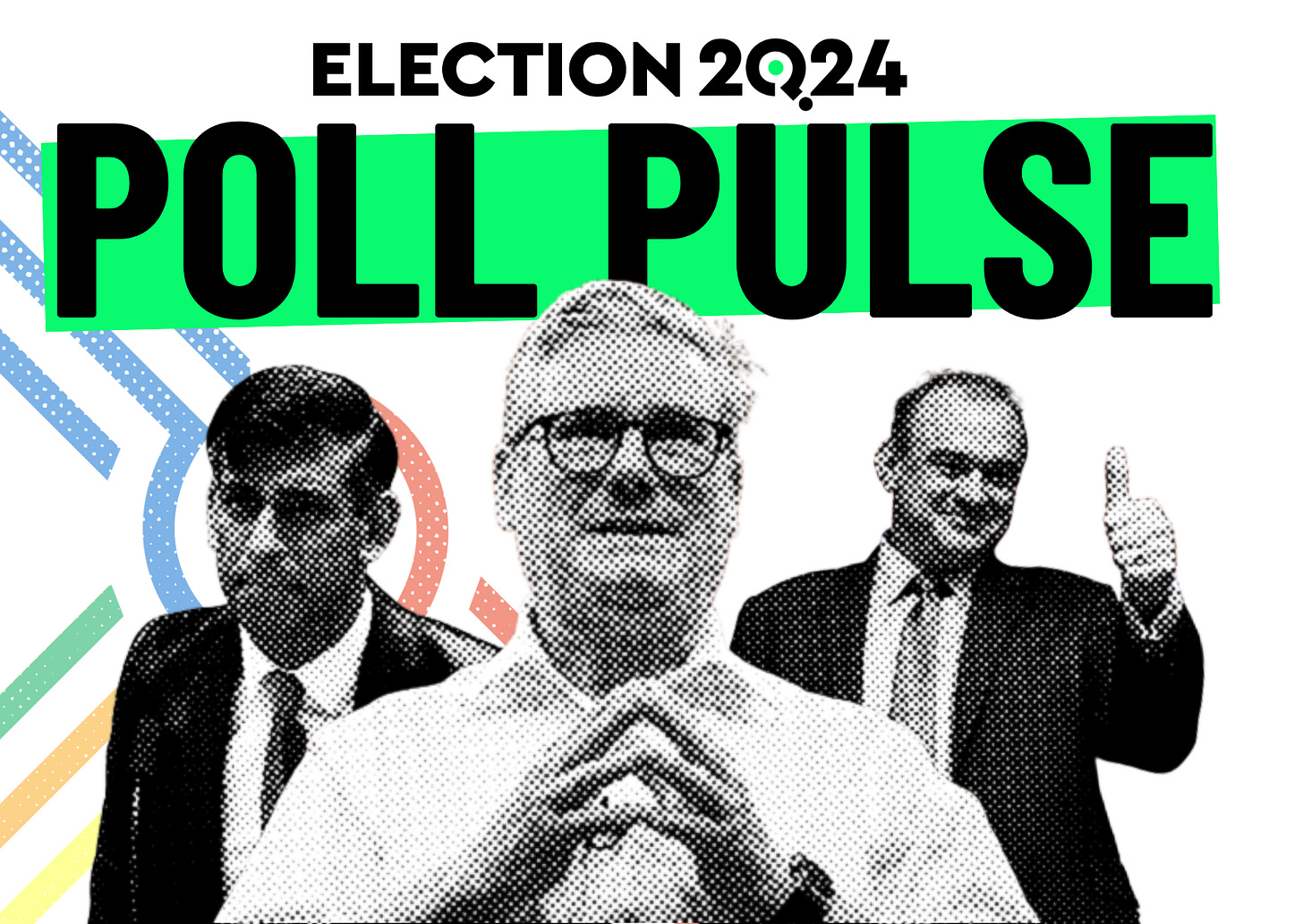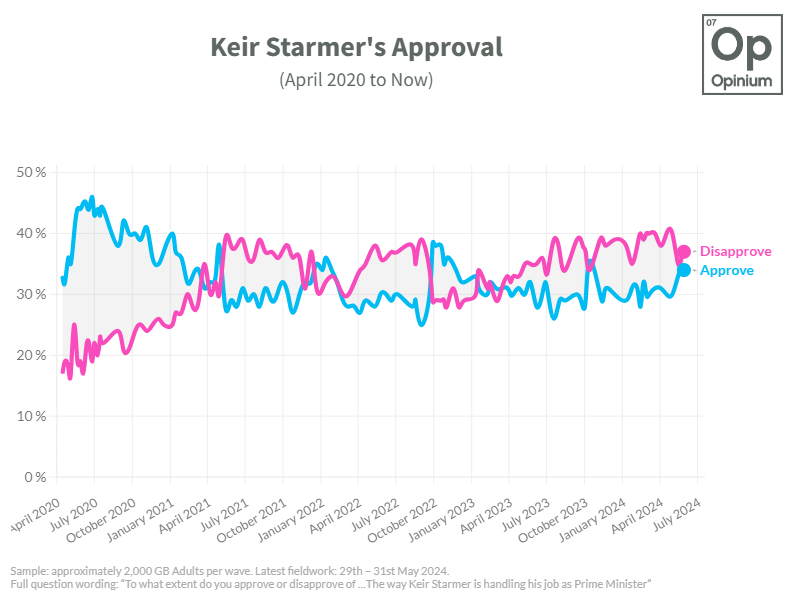Poll Pulse #1: Tentative First Steps
A weekly series focusing on the data and polls of the election
If you have enjoyed the last few months or years reading The Political Inquiry, we would appreciate anything you can give back with a free or paid subscription. All donations received will be put back into the Substack in order to continue its development. Thank you to those who have already subscribed and donated.
Just to reiterate ourselves once more, the 2024 General Election is underway. As Tom Egerton previously mentioned, this series will look to provide a general encapsulation of the trends in public opinion polls, in order to provide the best picture for what the country will decide on the 4th of July.
When it comes to talking about polls, it’s critical to take into account the variance between the different polls, be that in the scale of the data they collect or how they treat the data. Ultimately, polls are not created equally. Whether that be due to significant variations in sample sizes, or the treatment of the responses that are received, which form the polls themselves. Polls have variance in their treatment of results, and this can lead to a difference in results, even if presented with identical data. Wonderfully demonstrated by the below graphic from FocalData, polls can be significantly different in how they operate, particularly when it comes to their treatment of any responses in the ‘Don’t Know’ category, which appears potentially significant this year.
As Election Maps UK specifies:
1. Most simply exclude them from the headline figures.
2. Some ask a further 'if you had to choose...' squeeze question.
3. Opinium & JL Partners try to model how they will end up voting, with JL Partners' modelling appearing to benefit the Tories slightly more than Opinium's.
In the case of the re-weighting models, these will likely lead to greater support for the Conservatives, particularly when accounting for issues such as turnout, which the Conservatives outperform other parties in. These models seek to apply their understanding of where they believe the Don’t Knows would vote, and owing to the greater disenfranchisement of previous Conservative voters, there is a belief that a large percentage of this demographic are likely to go on to vote Conservative come election time. Hence, these forecasters return smaller Labour leads, because of the re-weighting. But because we cannot unequivocally claim that this will or will not occur, it’s impossible to suggest that one method of treating the ‘Don’t Knows’ is superior to another. Beyond simply scale, it is difficult too suggest that any one poll is more significant than another. Polls and their results will vary but any comparisons drawn between polls must take these differences into account.
Where we were
Having covered a background on polling, it’s important when discussing any movement in polls to lay out the points which we compare it to. As mentioned previously, most had expected Sunak to call the election in the autumn, partly because of the Conservatives’ poor polling, and the lack of progress in key areas, such as successful management of the economy or deliverance on the Rwanda immigration plan. Sunak appeared to gamble, having received the now-overshadowed positive figures on the reduction in inflation rates, and called the election day of, one of the final opportunities before the summer recess. Regardless of this small inflation-based success story, going into the election things were not looking rosy for Sunak. The variance on Conservative votes in polls saw them operate with a mean of around 23%, with some polls seeing a gap to Labour as high as 26%. Most notably for the Conservatives, especially when regarding the voters they appear to be targeting with their policy proposals, Reform were operating with a mean of 11%, which whilst unlikely to provide them a seat, would be significant enough to considerably damage the Conservative seat outcome.
As of the 27th, seat projections were not looking favourable towards the Conservatives.
Where we are now
But over a week has gone on since the call of the election. Many commentators had suggested that with an election now in sight, the gap between the main political parties would begin to close, as the Conservatives ramped up into election mode. Such a prediction actually occurring would have made writing this piece an earlier task, but for much of the first week of the campaign, it was difficult to suggest that any movement had occurred from the beginning of the election at all. Early polls, as of May 28th appeared to show limited significant movement, towards any parties:
LAB: -0.1% to 44.1%
CON: -0.1% to 23.3%
RFM: +0.3% to 11.3%
LDM: +0.1% to 9.6%
GRN: -0.5% to 5.9%
SNP: +0.1% to 2.9%
The closest hint we had seen for any chance of movement was the similarities between their parties in providing results for a marginal Labour vote percentage extension. Outliers still occurred, such as the JL Polling result, which saw only a 12 point gap between the two parties. However, as specified earlier, the JL Polling poll is not a nowcast, and is significantly more predictive. Not only does it seek to sort the Don’t Knows, but it also brings into account aspects such as turnout, drawing its results significantly outside of the wider consensus.
This piece was delayed by the whispers surrounding the Electoral Calculus MRP, the first significant MRP poll of the election. The poll, taken from fieldwork between the 20th-27th of May, with a sample size over 10,000, caused significant stir, with the results as follows:
The media, reasonably fairly, have had a field day with such a result. Ed Davey was suddenly on the verge of becoming leader of the opposition, in a result for the Conservatives which looked to rival Canada 1993. But it is important to not get too far ahead of ourselves, and to simply take this poll in isolation. The poll saw underlying figures which landed in the upper half of predicted Labour voting percentages, seeing 46% instead of the mean of 45% and significantly below the mean for the Conservatives, at 19% rather than 23%. The poll remains significant, but it is still important to take this into account.
But, as time has gone on, it does appear that movement towards Labour may well have occurred, at least when taken alongside the Opinium released on the 1/6/24 from fieldwork between the 29-31st of May. Previously providing one of the smaller gaps between the parties, the Opinium poll saw the Labour preference grow by 4%, and the lead grow to 20 points. This is the highest result for Labour in an Opinium poll since the Truss leadership, which is a hugely significant step, especially because Opinium are a pollster who rewights the ‘Don’t Knows’, a method which typically favours the Conservatives.
Party figures will always dominate the conversation, and rightfully so, but it is also critical to take into account the individual popularity of leaders. Each leader's personal ratings look likely to play a significant role in the general election, considering the almost presidential treatment of this election. The first period of the election campaign does not appear to have enamoured voters toward either Sunak or Starmer, at least in the view of the recent Opinium poll with both down from the previous week.
Keir Starmer, whilst still regarded as less popular than his party, does get to enjoy a significant advantage in public perception over Sunak, net -3 to Sunak’s net -33. Despite his best efforts with his antics, the population still remains largely unsure on their opinions of Ed Davey.
Conclusion
So where does this leave us? Labour certainly enjoys a hearty lead, one which does seem to be expanding - there is certainly no sign of a narrowing, which many had predicted would occur. But in a pre-debate and manifesto period, there is still significant room for movement for many of the parties. However, it feels like something monstrous would have to occur now to shake Labour from their likely majority.
Thank you for reading, if you enjoyed the piece please subscribe, like and share. You can follow Dylan on twitter (now X) @cridland_dylan












